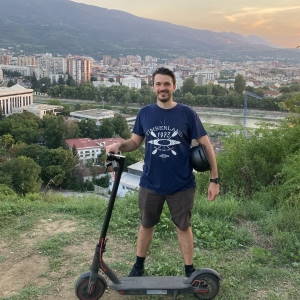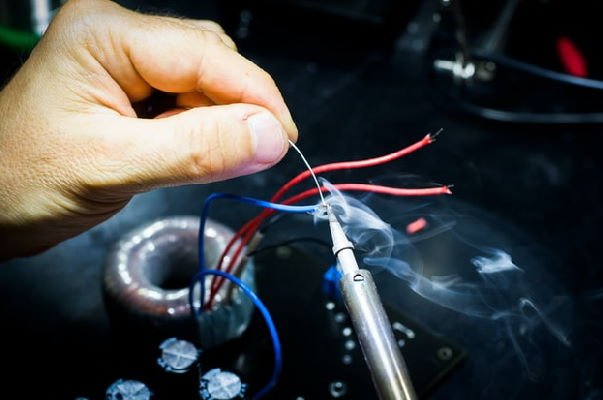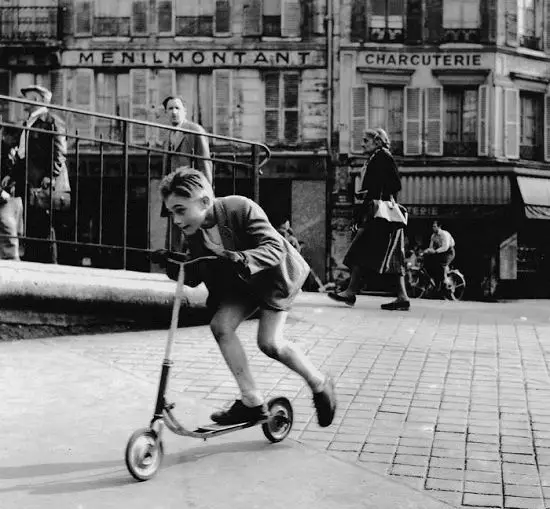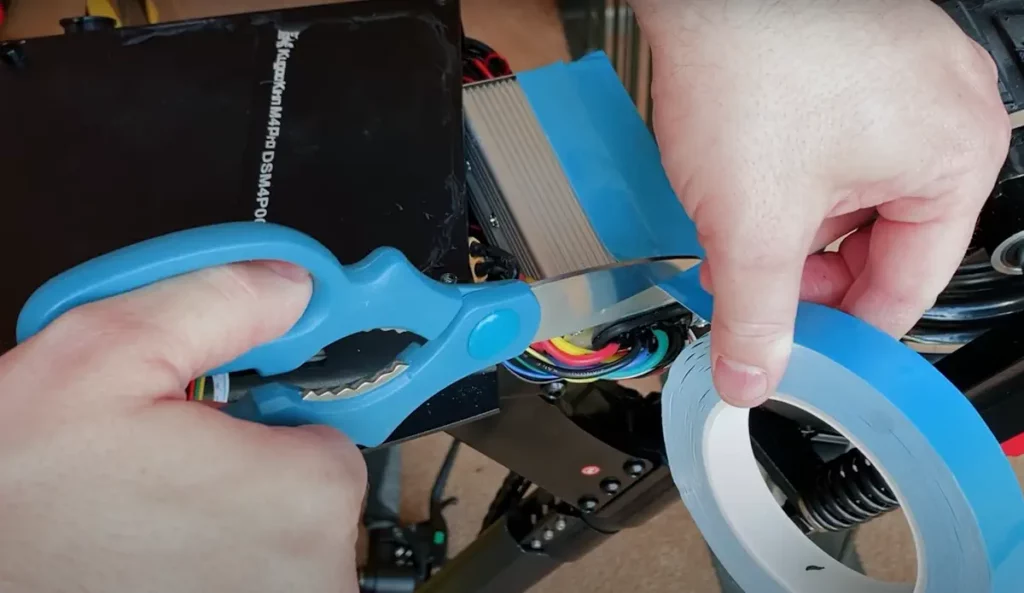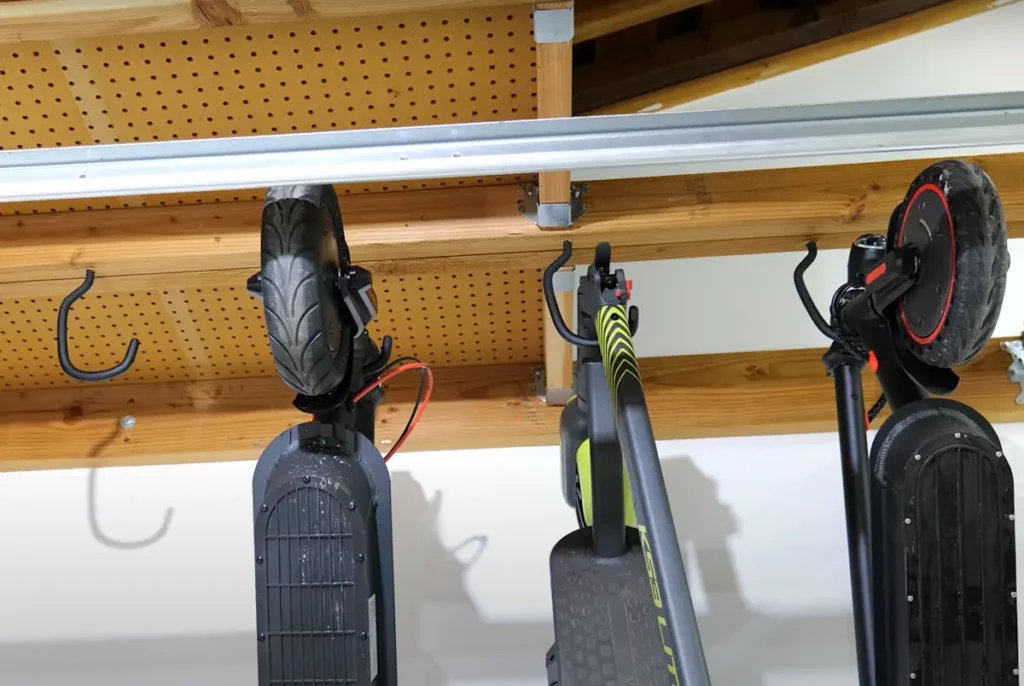This is a guide on electric scooter tire pressure. We’ll provide straightforward advice to help you maintain the right tire pressure for a safer and smoother ride on your electric scooter.
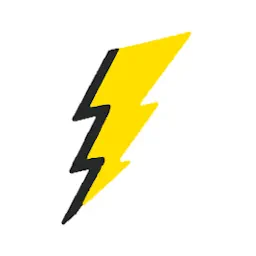
Electric scooter tire pressure
The recommended tire pressure for most electric scooters is between 40 and 50 PSI. For more traction, subtract about 3-5 PSIs, and for higher speeds, add about 3-5 PSIs. Lighter riders should reduce pressure by 3-5 PSI, while heavier riders should add the same pressure. Reduce the tire pressure by 2-3 PSI in hot weather (32°C / 90°F or hotter)
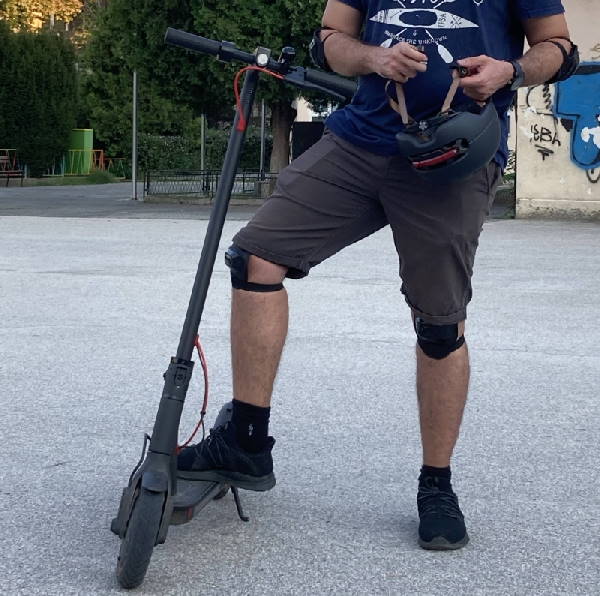
How to find the exact tire pressure for my electric scooter?
Factors like your weight, terrain, tire size, weather, and your preference for speed or traction determine the right tire pressure.
To find your ideal tire pressure, you have two straightforward options:
- check your user manual that came with your scooter
- check the tires themselves, the recommended pressure is usually written on the side of the tire
If the manual and the tire suggest different values, prioritize the manual. Scooter manufacturers have tested the tires on your specific model, so their recommendations are more reliable for real-world use.
The tire value is typically the maximum pressure, not necessarily the ideal for your situation.
When I first got my Xiaomi M365 Pro, I didn’t exactly know what the tire pressure should be.
There was some conflicting online advice and limited information in the manual. I later realized that tire pressure requires attention and isn’t a “set-and-forget” matter.
Recommended tire pressures for popular electric scooters
These are some of the tire pressures that the most popular brands and manufacturers suggest for their models.
| Electric scooter model | Recommended tire pressure (PSI) | PSI for riders under 70 kg / 155 lbs | PSI for riders over 90 kg / 200 lbs |
|---|---|---|---|
| Swagtron Swagger 5 | 25-28 | 25 | 30 |
| Swagtron Swagger 5 Elite | 25-28 | 25 | 30 |
| Ninebot Max | 32-37 | 32 | 40 |
| Inokim Light | 35 | 30 | 40 |
| Inokim Light 2 | 35 | 30 | 40 |
| Inokim Light 2 Limited | 35 | 30 | 40 |
| Joyor A1 | 36 | 31 | 41 |
| Joyor F3 | 36 | 31 | 41 |
| Joyor F5+ | 36 | 31 | 41 |
| Joyor F5S+ | 36 | 31 | 41 |
| Joyor X1 | 36 | 31 | 41 |
| Joyor X5S | 36 | 31 | 41 |
| InMotion Lively | 43 | 38 | 48 |
| Emove Cruiser | 45 | 40 | 50 |
| Imax S1 | 45 | 40 | 50 |
| Inokim Quick 3 Hero | 45 | 40 | 50 |
| Inokim Quick 3 Super + | 45 | 40 | 50 |
| Qiewa Q1 Hummer | 45 | 40 | 50 |
| Speedway 4 | 45 | 40 | 50 |
| Kaabo Mantis | 40-45 | 40 | 45 |
| EVOLV City | 40-50 | 40 | 50 |
| EVOLV Pro | 40-50 | 40 | 50 |
| EVOLV Tour | 40-50 | 40 | 50 |
| Inokim Mini 2 | 43-50 | 43 | 50 |
| Inokim OX 13Ah | 43-50 | 43 | 50 |
| Inokim OX 21Ah | 43-50 | 43 | 50 |
| Inokim OXO | 43-50 | 43 | 50 |
| Dualtron 2 | 45-50 | 45 | 50 |
| Dualtron 3 | 45-50 | 45 | 50 |
| Dualtron Compact | 45-50 | 45 | 50 |
| Dualtron Raptor | 45-50 | 45 | 50 |
| Dualtron Spider | 45-50 | 45 | 50 |
| Dualtron Thunder | 45-50 | 45 | 50 |
| Dualtron Ultra 2 | 45-50 | 45 | 50 |
| Dualtron X | 45-50 | 45 | 50 |
| Speedway 5 | 45-50 | 45 | 50 |
| Swagtron Swagger 7 | 45-50 | 45 | 50 |
| Xiaomi M365 | 45-50 | 35-40 | 50 |
| Xiaomi M365 Pro | 45-50 | 35-40 | 50 |
| GoTrax XR | 50 | 45 | 55 |
| GoTrax XR Ultra | 50 | 45 | 55 |
| Hiboy Max | 50 | 45 | 55 |
| Speedway Leger | 50 | 45 | 55 |
| Turbowheel Dart | 50 | 45 | 55 |
| Levy | 50-60 | 50 | 60 |
| Levy Plus | 50-60 | 50 | 60 |
| GoTrax GXL Commuter | 50-75 | 50 | 75 |
| Turbowheel Lightning | 55 | 50 | 60 |
| Zero 10 | 55 | 50 | 60 |
| Zero 8 | 55 | 50 | 60 |
| UberScoot S300 | 60 | 55 | 65 |
| EcoReco L5 | 60-80 | 60 | 80 |
| EcoReco M5 | 60-80 | 60 | 80 |
| EcoReco S5 | 60-80 | 60 | 80 |
| EcoReco XS | 60-80 | 60 | 80 |
Xiaomi M365 tire pressure

The manual of the Xiaomi M365 and the Xiaomi M365 Pro and the stress tests have a bit different results on the recommended tire pressure.
The user manual of the Xiaomi M365 and the Xiaomi M365 Pro states that the recommended tire pressure should be between 45 and 50 PSI.
After rigorous stress tests, I recommend specific tire pressures based on rider weight:
- 110-155 lbs / 50-70 kg: 35-40 PSI for the front wheel, 40-50 PSI for the rear wheel
- 155-200 lbs / 70-90 kg: 40-45 PSI for the front wheel, 45-55 PSI for the rear wheel
- 200-220 lbs / 90-100 kg: 45-50 PSI for the front wheel, 50-60 PSI for the rear wheel
- more than 220 lbs / 100 kg: 50-55 PSI for the front wheel, 60-65 PSI for the rear wheel, and driving more carefully as the risk of flats is increased
If you suspect valve problems, it’s wise to consult an authorized dealer for repairs or replacement.
Different tire pressures in the front and rear tires
Some scooter owners, and some brands, recommend less tire pressure in the front tire, and more in the rear. As you can see in the Xiaomi example above, the recommended front tire pressure is lower than the one of the rear.
Others recommend the opposite.
This usually depends on where the hub motor is located in single-motor scooters.
Usually, it is in the front wheel, which can cause increased front tire pressure due to motor-generated heat.
Electric scooter tire pressure factors
These are the most important factors affective tire pressure for scooters.
Weather
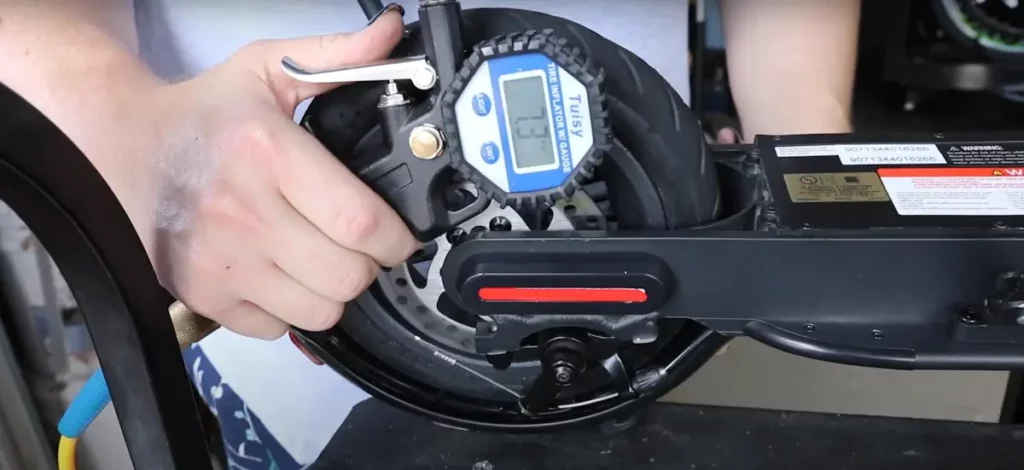
Excessive heat, from extended rides or hot weather, raises tire pressure.
In temperatures of 32°C / 90°F or higher, reduce tire pressure by 2-3 PSI for hot weather riding.
In cold weather, you might consider a slight PSI increase in theory, but it’s safer to maintain lower pressure for better traction on icy, snowy, or wet surfaces during winter rides.
Avoid the hassle of daily pressure adjustments based on weather.
For hot summers, reduce tire pressure by 2-3 PSI at the start and revert by summer’s end. Check the electric scooter summer guide and the best electric scooters for the summer for more information.
Rider weight
Lighter riders need lower tire pressure, while heavier riders need more.
For riders weighing 155-200 lbs / 70-90 kg, use the recommended pressure. If you weigh less than 155 lbs / 70 kg, reduce pressure by 3-5 PSI or more.
If you weigh more than 200 lbs / 90 kg, increase pressure by 3-5 PSI or more.
Experiment with different pressures to find your ideal riding experience.
Performance
Higher tire pressure will provide you with:
- higher speed
- fewer flats
- better steering
- less shaking
- better suspension and a smoother riding experience
- better range and performance overall (in most cases)
On the other hand, lower tire pressure will give you:
- better traction
- possibly better climbing abilities because of the improved traction
- better performance on wet, slippery, or muddy terrain
That means going with normal or slightly increased tire pressure for most situations.
In hilly or wet areas, consider lowering tire pressure by a few PSI.
How to check the tire pressure on my electric scooter?
There are two ways to check your tire pressure:
- using a tire pressure gauge
- lightly kicking the tire
The second method doesn’t measure pressure precisely but offers a quick, tool-free check. A light kick ensures they’re not flat.
For an exact reading, use a tire pressure gauge. Be aware that the procedure may decrease pressure slightly.
Car tires typically use 30-35 PSI, and your car gauge can often work for scooters too.
For the best results and precision, I recommend Chrome 10-100 PSI Pencil Tire Gauge on Amazon. It’s affordable, displays pressures from 10 to 100 PSI, and works accurately with any scooter tire.
If your scooter doesn’t come with a pump, consider the Bell AIR Glide 550, which also includes a built-in pressure gauge. You can find it on Amazon here.
How often should you check tire pressure?
Do a quick kick-check before every ride, and try to measure the exact tire pressure at least once a week as part of your regular cleaning and maintenance routine.
What happens if the tire pressure is too low?
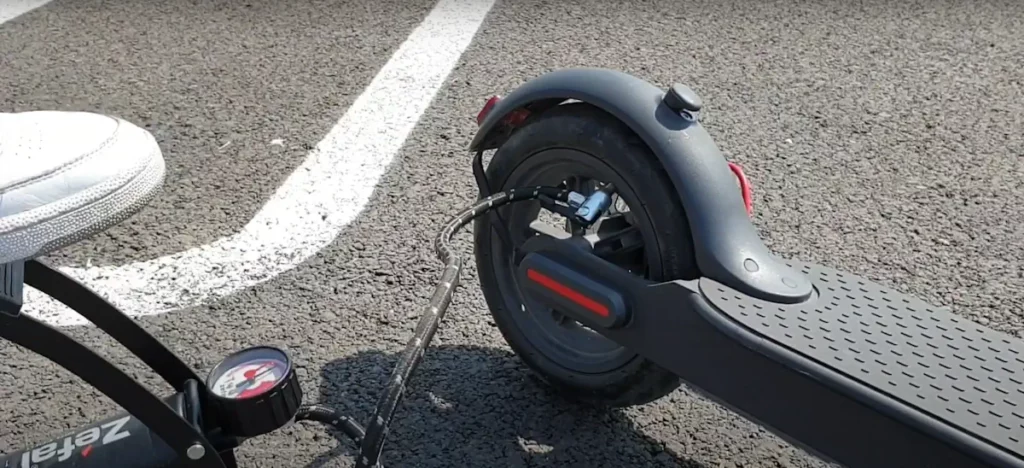
If your tire pressure is too low, you will see several symptoms:
- you steer and turn with more difficulty
- your rims may show some bents or damage
- your rides are too shaky and your scooter vibrates a lot
If you notice some of these things, check your tire pressure. You may need to inflate your tires a bit more.
What happens if the tire pressure is too high?
Over-inflated tires can cause flats, increased shock sensitivity, and even explosions, especially with heavier riders. They also reduce traction and control on your scooter.
How to prevent flat tires on an electric scooter?

Higher tire pressure reduces compression during impacts and is a top method to prevent flats.
These are all the general tips to prevent flat tires:
- make sure your tires are inflated
- don’t ride in wet weather, it’s easier for debris to stick on your tires
- ride with your entire body, slow down and bend your knees when hitting a bump
- maintain and clean your scooter often, you may prevent a cause for a flat before it happens, like discovering a small piece of glass stuck on your tire
- fill tires with Green Slime or some other sealant, you can find this extremely cool and useful product on Amazon
- check for leaky valves that cause air leakage and loss of tire pressure
Check the flat tire guide to learn about all the tips in detail, how to prevent flats entirely, and how to fix them if needed.
When should I replace a tire?
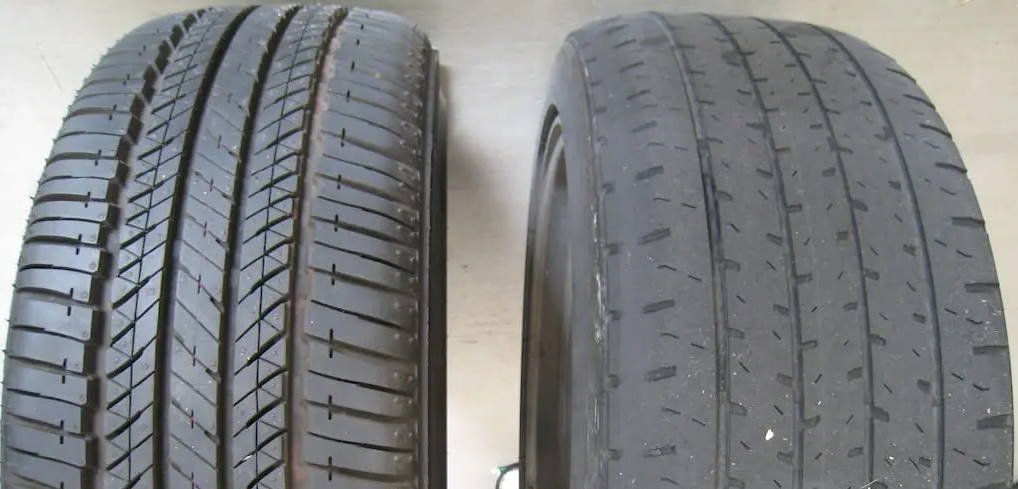
Tires last for years, and even in the case of a flat, you might only need to replace the inner tube. Replace tires when they appear worn out, with visible damage or lost knobs.
PSI vs Bar
The SI System (metric system) measures pressure in Pascals (Pa). For practical purposes, it’s often expressed in Bars (Ba), where 1 Bar equals 100,000 Pascals.
However, the Imperial System uses the Pounds per Square Inch unit (PSI).
While the Metric System is widespread globally and the Imperial System is mainly used in the US, PSI is the commonly accepted unit for pressure, although Bars are also used.
1 Bar equals 14.5 PSI, and 1 PSI is 0.068 Bars.
You can use this pressure converter for a simple calculation.
For quick conversions, use Google by typing, for instance, “45 PSI to Bar” or “3 Bar to PSI” to get instant results.
No, it’s not safe to ride an e-scooter with flat tires as it can lead to loss of control and accidents. Always maintain proper tire pressure for safety.
Yes, tire pressure matters for foldable e-scooters. Correct tire pressure ensures better traction, handling, and overall performance. It’s essential for a safe and smooth ride.
Consult your scooter’s manual or reach out to the manufacturer for guidance. They can recommend the best tire options for your specific scooter model.
If your scooter is compatible, you can put pneumatic tires on it. Make sure to check your scooter’s specifications and any manufacturer recommendations before making the switch.
Bigger tires can offer a more comfortable and stable ride on electric scooters. They can handle uneven terrain better and provide improved shock absorption, making for a smoother and more enjoyable riding experience.
